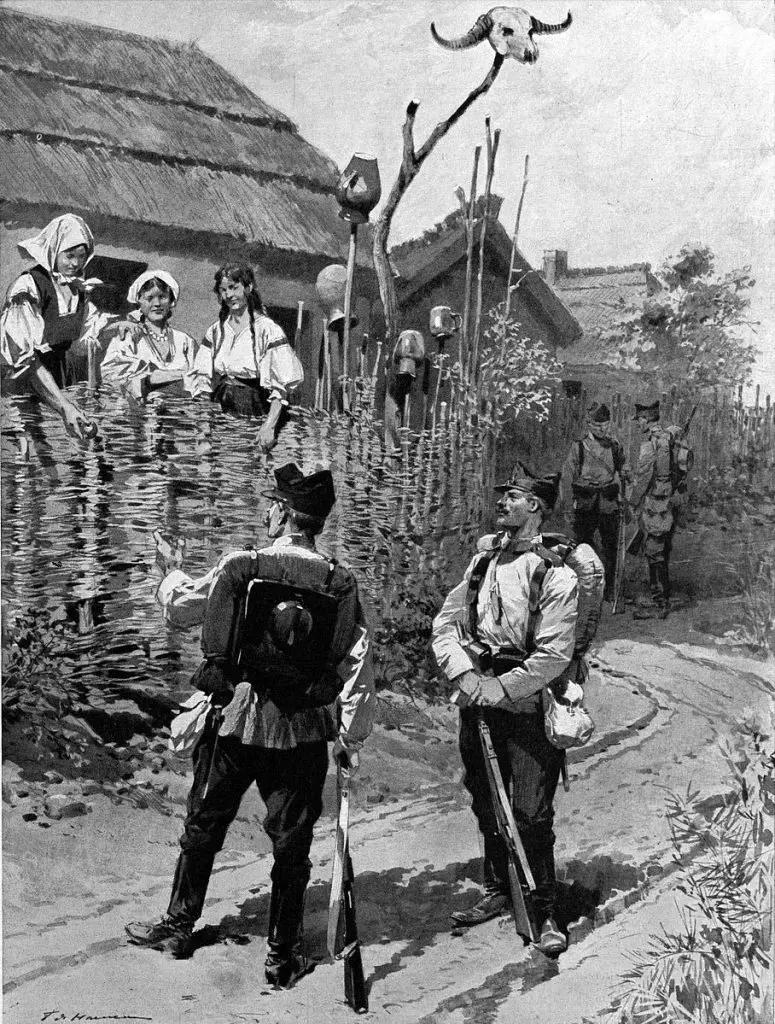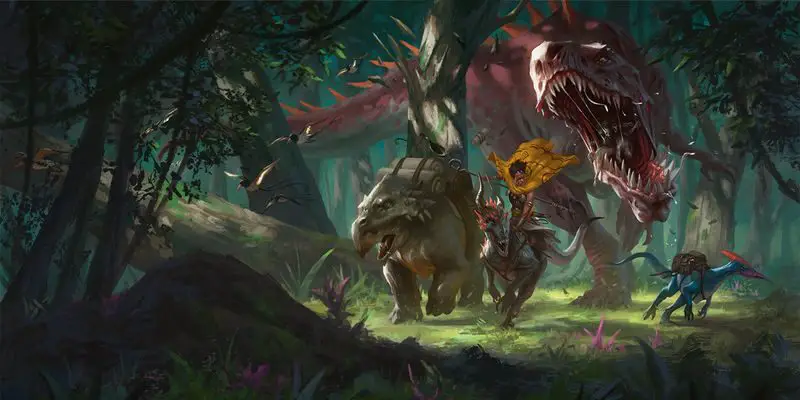Oak’s Crossing by JonasDeRo, Creative Commons Attribution-Noncommercial-No Derivative Works 3.0 License
As implausible as fantasy may seem, reality has thrown us some major curveballs. I have found that real-world history provides a bounty of phenomena that we can use as inspiration for rich Dungeons and Dragons settings, world-building, and encounters. Let’s explore a few interesting ideas and how a Dungeon Master could use them to inspire their adventures.
A Village Under Quarantine: Cordon Sanitaire

Before the advent of modern medicine, small villages infected by plague would often have no option but to seclude themselves and let the disease run its course. In the 17th century, the English village Eyam identified a bout of the bubonic plague. Swiftly, village leaders imposed cordon sanitaire. They set out stones to line the village boundaries and required its entire population to stay within.
Neighboring villages would drop off food and goods outside of the perimeter in return for coins sanitized with vinegar. Though 80% of Eyam’s population perished from the plague, the disease stopped at their borders.
Incorporating Into Your Campaign:
Revolve a quest around someone inside of the plague zone: the daughter of a neighboring noble was kidnapped and believed to be inside the village before it was quarantined; a master swordsmith who can craft a legendary weapon to defeat a demon lord refuses to leave behind his family and town; the village is the hometown of one of your party members, who still has family within.
Have your party visit the town during the initial outbreak, forcing them into quarantine as well. Perhaps the god of your party’s Paladin requires his aid in healing this village, or the party Cleric feels the pull to help these people out. Maybe the plague was brought on by an evil presence, or people suspect the village doctor is spreading an illness.
The Mellified Man: Death Rituals and Almost Cannibalism
We briefly wrote about this in our Death Rituals article. Warning, this may make your stomach squeamish. Ancient records of mellification denote that early civilizations such as the Assyrians, Egyptians, and Chinese would sometimes embalm their dead in sarcophagi filled with honey, which would preserve the persons’ tissues and organs. A few months before decease, the dying would refuse food or drink except honey until their bowels were filled with it. Then they were submerged into their liquidy tomb.
After a century of mummification in this sticky swill, an ailed individual could ingest a small amount of the corporal confection to cure their disease, heal their wounds, or assist their body in repairing fractures.
Incorporating Into Your Campaign:
This might just be interesting lore to mark specific cultures in your campaign. Perhaps a shop can sell an indigenous “healing potion” made from a mellified man. Could someone of great fame go for a higher price than a commoner? Maybe a person must be pure of heart to be mellified in a religious ritual to their deities.
Your party could meet someone preparing themselves for mellification. It could be a great honor in a society to be chosen for mellification, as they would have to be generally healthy, or maybe even considered holy.
Your party could solve a missing persons case by discovering that they were mellified to hide the body.
Stylite Pillar Saints

In accordance with a life of abstinence from pleasure, some Christian saints may have chosen to live, proselyte, and pray on top of large pillars in an attempt to put off their body’s sinful nature and purify their soul. One stylite dwelt on a pillar for 37 years. Modernly, an Orthodox monk in Georgia lives in solitude on top of the Katskhi pillar, and only descends twice per week.
Incorporating Into Your Campaign:
A wanted criminal could be masquerading as a pillar saint, beloved by the people he’s fooled. A legitimate stylite could be sowing political dissent, and in hot water with the local rulers. Pillar Saints could be an area-specific detail that characterizes a civilization. Perhaps your party must traverse to a secluded monolith to find a particular monk. Maybe an ancient manuscript pertinent to your adventure resides inside.
The Lake Nyos Gas Cloud: Limnic Eruptions
In 1986, a small Cameroon village woke one morning to find over 1,700 friends and family members and 3,500 livestock dead in their sleep. The culprit: a sudden gas cloud released from the nearby lake.
Over time, carbon dioxide and sulfur compounds built up beneath the surface of the lake. Like a thief in the night, gas erupted to the surface at 62 miles per hour. Without warning, the dense gas cloud descended into the valley housing this small community, devastating the lives of thousands.
Incorporating Into Your Campaign:
This disaster could befall a town before or while your players are within its walls. Make your players roll Constitution saving throws, give them wild dreams resulting from the poison, have them discover the cause of the gas cloud and handle the dismal humanitarian aftermath.
Perhaps the cause seems more sinister, like a cult’s sacrifice, a god’s wrath, or a necromancer’s plot. Sow the seeds of distrust amongst the villagers, offering rewards to the adventuring party who can solve the mystery of their loved ones’ deaths.
Kumari: The Living Goddess

In the Hindu worship, a young girl is chosen to embody a living goddess, revered for her premenstrual purity. After her first menstruation, it is believed that the goddess leaves her body. Displayed during certain festivals, the Royal Kumari takes on an entirely new character: omniscient, secluded from family, carried on a golden palanquin, and bid to bestow blessings to kings and low castes alike. While receiving audience, her reactions predict the fortune of petitioners: crying, laughter, weeping, trembling, clapping, and refusing to eat can all be signs of misfortune.
The Kumari (“living goddess”) of Patan by Christopher J. Fynn, CC License
Incorporating Into Your Campaign:
Players may seek audience with a child possessed by a deity, who has significant influence with local leaders. A wicked councilor or secret cult may be holding the child-ruler’s family hostage to influence ruling for his own gain (think Wymrtongue, but extortion methods instead of magic). A young child may be forced into this role against her will and begs the party to take her away.
Roman Army Decimation
In Ancient Rome, as punishment for a legion’s cowardice, mutiny, rebellion, or desertion, commanding officers would require every tenth man, determined by lot, to be executed by the rest of the legion, either by stoning, stabbing, or clubbing.
Incorporating Into Your Campaign:
Your players may encounter this if they were to join forces with a military force, be recruited by a legion, or in a strict military community. Tug at your players’ emotions by making connections with certain members of the legion. Perhaps your party finds a deserted legion for paying commanders, only to discover this punishment as a result.
Otzi the Iceman
In 1991, two German tourists in alps of the Austrian–Italian border discovered a well-preserved body frozen from below the torso in ice. Upon inspection by a medical examiner along with other objects found nearby, the body was dated to be about four-thousand years old.
Interestingly, Otzi had 61 tattoos, which had a pigment created from soot, which are believed to have been related to pain-relief like acupuncture. Otzi had leather clothes from ancestral beasts, wide snowshoes, and a leather pouch containing ancient tools, flint, bone awl, and dried fungus.
There are many theories to how Otzi died: ritual sacrifice as chieftain, succumbing to wounds post-battle; it’s been theorized that he died from battle wounds and then was placed in a stone burial mound, and with each thaw cycle, moved slightly down the mountain.
There are also reported cases of a manifestation of a curse associated with those who discovered and recovered Otzi’s body, as four of seven deaths of those who had a hand in his exhumation have died under cryptic circumstances.
Incorporating Into Your Campaign:
Adding an ancient discovery such as Otzi to your campaign could ensue a myriad of adventures: after discovering some powerful artifacts, adventurers flock to ice-capped mountains in search of more potent items; a village learns about their tragic past through the discovery of an iceman; those cursed who have unearthed an iceman hire the adventuring party to find a way to remove the bane. Perhaps the ancient man was preserved through magic and thaws with a beating heart.
Ilha da Queimada Grande: Snake Island
Off the coast of Brazil, you’ll find an island with a population of 0. Humans, that is. Snakes: 1 per square meter. It is believed that snakes became trapped when rising sea levels cut them off from the mainland. Within this new environment, and without any predators, the snakes rapidly reproduced and produced deadlier venom, making the island inhabitable. Eventually, Brazilians erected an ominous automated lighthouse on the shore to signal ships away from the world’s deadliest island.
Incorporating Into Your Campaign:
A government could hire the adventuring party to clear an island of a dangerous predator; the adventuring party might shipwreck on such a dangerous island; a village may hire the adventuring party to find a group of young boys whose fishing boat was forced to dock on the island during a tropical storm.
Interested in More Plot Hooks?
Check out these Werebeast Plot Hooks.
You can also find dozens of maritime adventure hooks in our Sea Adventure Module.




